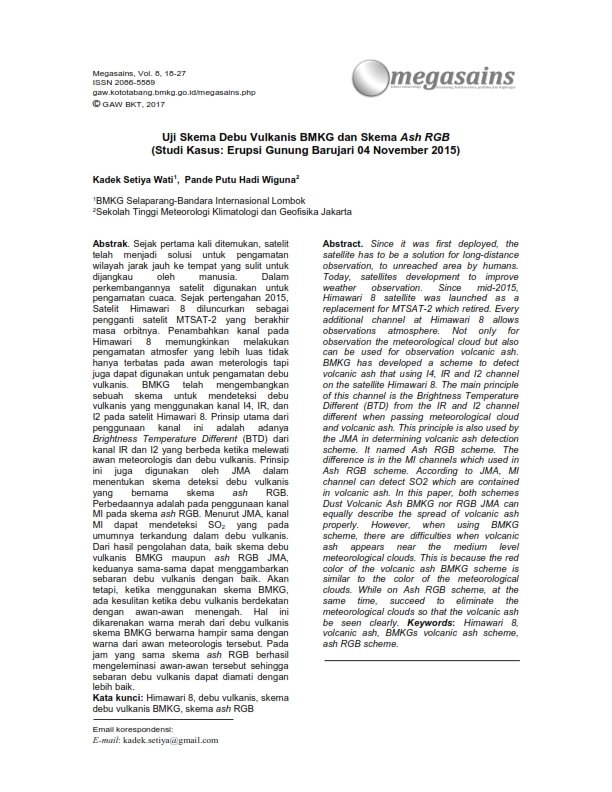Test the BMKG Volcanic Dust Scheme and RGB Ash Scheme (Case Study: Mount Barujari Eruption 04 November 2015)
Main Article Content
Abstract
Abstract. Since it was first deployed, the satellite has to be a solution for long-distance observation, to unreached area by humans. Today, satellites development to improve weather observation. Since mid-2015, Himawari 8 satellite was launched as a replacement for MTSAT-2 which retired. Every additional channel at Himawari 8 allows observations atmosphere. Not only for observation the meteorological cloud but also can be used for observation volcanic ash. BMKG has developed a scheme to detect volcanic ash that using I4, IR and I2 channel on the satellite Himawari 8. The main principle of this channel is the Brightness Temperature Different (BTD) from the IR and I2 channel different when passing meteorological cloud and volcanic ash. This principle is also used by the JMA in determining volcanic ash detection scheme. It named Ash RGB scheme. The difference is in the MI channels which used in Ash RGB scheme. According to JMA, MI channel can detect SO2 which are contained in volcanic ash. In this paper, both schemes Dust Volcanic Ash BMKG nor RGB JMA can equally describe the spread of volcanic ash properly. However, when using BMKG scheme, there are difficulties when volcanic ash appears near the medium level meteorological clouds. This is because the red color of the volcanic ash BMKG scheme is similar to the color of the meteorological clouds. While on Ash RGB scheme, at the same time, succeed to eliminate the meteorological clouds so that the volcanic ash be seen clearly.
Article Details

This work is licensed under a Creative Commons Attribution-NonCommercial 4.0 International License.
The author is willing to retain the copyright and grant journal rights to the first publication with works that are simultaneously under license the Creative Commons Attribution-NonCommercial-NoDerivatives 4.0 International. It allowing the others to share the work with recognition of the author's work and the initial publication in this journal.
Authors can enter into separate additional contractual arrangements for the non-exclusive distribution of published versions of journal works (for example, posting them to institutional repositories or publishing them in a book), with recognition of the initial publications in this journal.
Authors are permitted and encouraged to send their work online (for example, in their institutional repositories or websites) before and during the submission process because it can lead to productive exchanges, as well as previous and larger citations of published works.

